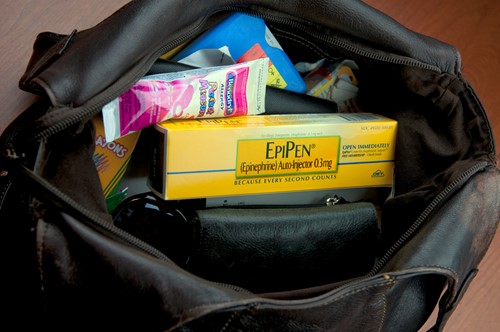
Food Allergies and Intolerances
9/19/2022
Food allergies affect people of all ages but are increasing in children. Currently, 1 in 25 children are affected by food allergies. This number increased over 18% from 1997 to 2007.
Food allergies are when the body reacts to food like it is a foreign substance that is bad for the body. Specifically, food allergies are reactions to protein in foods. Proteins contain antigens that are specific to that food. During an allergic reaction, the body makes an immune response in reaction to the antigen.
Exposure to the food antigen triggers a chemical response in the body. This chemical response results in symptoms. Symptoms can occur immediately or hours after ingestion. Symptoms include
- Runny nose
- Sneezing
- Coughing
- Itching
- Stomach pain or cramping
- Diarrhea
- Rashes including hives
- Swelling
Anaphylaxis is a severe, potentially fatal systemic allergic reaction that can occur after contact or ingestion of the food antigen. If a person also has asthma, this type of reaction is more likely to be severe and possibly fatal. Symptoms include
- Respiratory symptoms
- Tight throat
- Cough
- Hoarse voice
- Shortness of breath
- Wheezing
- Cardiovascular symptoms
- Pale skin
- Flushed skin
- Blue skin
- Poor pulse
- Rapid pulse
- Low blood pressure
- Hives
- Swelling of face, lips, eyes, mouth/tongue
- Tingling of hands, feet, mouth, scalp
- Vomiting or nausea
- Diarrhea
- Lightheadedness
- Confusion
- Fainting
Often younger children have a hard time describing these symptoms. An infant may suddenly have increased drooling or may grab at their tongue or ears. An preschool or young school age child may use the following descriptions
- Hot or hairy tongue
- Funny-feeling mouth
- Bumpy tongue
- Something is stuck in their throat
- Itchy ears or bugs in their ears

Common Allergens
The most common food allergies are to cow’s milk, eggs, fish, shellfish, tree nuts, peanuts, wheat, and soybeans but there are 170 other foods that can cause allergic reactions. The amount of food ingested or contacted does not need to be large. In fact, 1/44,000 of a peanut kernel can trigger allergy in some people with peanut allergy.
Oral Allergy Syndrome
Oral Allergy Syndrome is a variant of food allergies. This syndrome occurs when pollen allergies cause a cross-reaction to fruits or vegetable proteins. Symptoms of oral allergy syndrome include oral itching, swelling of the mouth, and abdominal pain and it almost never progresses to anaphylaxis. Usually people with Oral Allergy Syndrome are able to tolerate cooked versions of these fruits and vegetables.
Diagnosis
Food allergies are diagnosed by an allergist. A diagnosis is made based on history, family history of food allergies, and skin or blood testing. Skin testing is when a small amount of food protein is placed under the skin to see if it causes a reaction or raised bump. A blood test uses a sample of blood to measure the immune system’s response to food by measuring IgE-mediated antibodies.
Allergists also offer oral food challenges. During a challenge a patient is given small amounts, with the amount increasing during that test or subsequent tests, of a suspected food and monitored for a reaction. This is often done to see if a person has outgrown a food allergy. Over 70% of children who are allergic to milk, wheat, or eggs will outgrow their allergy by adulthood.
Timing of Diagnosis
Food allergies can occur at any age but over 50% of all people with food allergies are diagnosed before age 6. Because reactions require ingestion of food, they are rare in small babies. Babies are rarely allergic to breast milk but 2 to 3 in every 100 babies will react to a food their mother has ingested. The most frequent trigger is cow’s milk. Luckily, cow’s milk allergy is often outgrown in the first few years of life. Babies often have different symptoms than older children ingesting an allergen. Their symptoms can include
- Severe colic
- Abdominal pain
- Eczema
- Hives
- Vomiting
- Diarrhea
- Blood stools
- Difficulty breathing after feeds

Treatment
The treatment for a food allergy is complete avoidance. This requires vigilance and reading food labels to detect any allergens. You should also be prepared to discuss food allergies and requirements with chefs or waiters when dining out.
The allergist will also prescribe epinephrine to be used in case of ingestion. Epinephrine is prescribed as an auto-injectable pen or cartridge. The pens and cartridges are dispensed in 2-packs that should be kept together in case a 2nd dose is needed after the first dose. They should not be left in extreme temperatures or light.
If a person ingests or may have ingested an allergen, they should administer epinephrine BEFORE serious symptoms occur. Treatment for reactions can also include antihistamines, such as Benadryl, but this does NOT replace giving epinephrine. If a person has a reaction and epinephrine was administered, they should be evaluated in the emergency room as a person can have a rebound of symptoms several hours after ingestion and treatment.
Prevention
The American Academy of Pediatrics (AAP) recommends breastfeeding exclusively the first 6 months of a baby's life to decrease the risk of or severity of food allergies in families with strong histories of food allergies. They do not recommend restrictions to mom’s diet if mom is breastfeeding.
The AAP also recommends early introduction of peanut-based foods to help prevent peanut allergies. In babies who are high-risk for developing a peanut allergy, meaning they have a strong family history of allergies, they recommend introduction between 4 to 6 months of age. For all other children, they recommend introduction at 6 months of age.
LIVING WITH FOOD ALLERGIES
School
If your child has an allergy and attends daycare or school, their program should be notified of their food allergy. The school should be provided with a food-allergy action plan, a list of foods to avoid, and a 2-pack of epinephrine pens or cartridges. Depending on their allergy, they may require a 504 plan for accommodations.

Holidays
Holidays need to be handled with care if your child has allergies. Your child should not eat any baked goods without confirming ingredients with you and the person who baked the item. Often, it can be best to avoid baked goods or provide an alternative baked good depending on your child’s allergen and allergy severity.
Halloween can also be tricky. Make sure you check labels before your child eats any treats and do not let them eat it if the ingredients aren’t listed. Often fun sized candies are made on different equipment than full size so may not have safe ingredients even if they tolerate the full sized item. Chocolate candies are at high-risk for trace allergen exposure and should be eaten with care. A candy exchange can be a fun way to trade unsafe candy for safe candy.
FOOD INTOLERANCE
Food intolerances are reactions people have to foods because of difficulty digesting them. This difficulty causes physical reactions but they are NOT food allergies. Unlike allergies, they do not involve the immune system.
Food intolerances can be caused by either sensitivity to a chemical in food or lack of an enzyme needed to digest a certain food.
Chemical Sensitivity
The most common chemicals that cause reactions include
- Monosodium glutamate (MSG)
- This is added to some foods or can occur naturally in parmesan cheese, tomatoes, or soy sauce
- Salicylates
- This chemical is found in fruits, veggies, coffee, nuts, spices, and honey
- Amines
- Amines are produced by bacteria in food during storage
- Foods include bananas, pineapple, avocados, citrus fruits, chocolate, cured meats, smoke fish, aged cheese, and wine
- Caffeine
- Sulfites
- These are preservatives added to foods

Enzyme Levels
Too little of an enzyme to digest a certain food can also cause food intolerance symptoms.
Lactose intolerance is the most common type of food intolerance with over 50% of the population not having enough enzyme to digest lactase, the natural sugar in cow’s milk. Lactose intolerance can be dose-dependent. This means the amount of lactose you ingest matters. Some people may not tolerate any lactose and some people may tolerate higher levels of lactose before becoming symptomatic.
Other foods that may cause digestion issues due to digestive enzymes include
- Beans
- Lentils
- Cabbage
- Apples
- Fructose (natural sugar found in fruits and veggies or used as a sweetener)
- Gluten (this intolerance is NOT celiac disease–that is an autoimmune disorder)
Symptoms
Symptoms of food intolerances are unpleasant but not dangerous. They include
- Burping
- Gassiness
- Bloating
- Indigestion
- Reflux
- Loose stools or diarrhea
- Flushed skin
- Rashes
- Hives
- Fatigue
- Anemia
- Nervousness
- Headaches
Diagnosis
Many food intolerances cannot be diagnosed via testing although gastroenterologists can do a breath test to check for lactose intolerance or carbohydrate malabsorption. There are food sensitivity tests heavily marketed online and available at pharmacies. These tests are NOT accurate or reliable. They test for IgG antibodies. These antibodies only show exposure to a food, not tolerance or intolerance.
The best way to diagnose food intolerance is trial and error. We recommend working with a gastroenterologist and nutritionist if you suspect a food intolerance and want to try a food elimination diet. This will ensure proper nutrition for your child during this process.
Treatment
There is no treatment for food intolerance besides lactose intolerance. Lactose intolerance cannot be cured but a person can consume food with lactase enzyme that has either been added to the food or by taking a lactase enzyme supplement when eating lactose-containing foods.
The best way to avoid uncomfortable symptoms is to avoid the triggering food. You may decide certain foods are “worth” the symptoms. Those symptoms can be treated with antacids and other comfort measures.
Resources
Websites:
Food Allergy Research and Education
And for books to help explain food allergies to kids click HERE.
Children’s Health Care of Newburyport, Massachusetts and Haverhill, Massachusetts is a pediatric healthcare practice providing care for families across the North Shore, Merrimack Valley, southern New Hampshire, and the Seacoast regions. The Children’s Health Care team includes pediatricians and pediatric nurse practitioners who provide comprehensive pediatric health care for children, including newborns, toddlers, school aged children, adolescents, and young adults. Our child-centered and family-focused approach covers preventative and urgent care, immunizations, and specialist referrals. Our services include an on-site pediatric nutritionist, special needs care coordinator, and social workers. We also have walk-in appointments available at all of our locations for acute sick visits. Please visit chcmass.com where you will find information about our pediatric doctors, nurse practitioners, as well as our hours and services.
Disclaimer: this health information is for educational purposes only. You, the reader, assume full responsibility for how you choose to use it.








